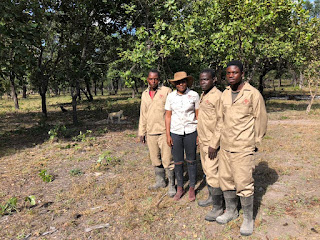While many young ladys are busy over the weekends
attending kitchen parties and slaying, Chipo gets busy with her cattle deep in
the heart of Chibombo district.
She smoothly strokes the cow’s back more like calming
it amidst the blazing heat that leaves one dehydrated.
Chipo Mwanawasa a Lawyer during the week and rancher
by weekend covers about 347 kilometers from Chingola on the Copperbelt Province
to Chibombo district in Central Province and another 110 kilometers of gravel
road to get to her farm.
Chipo feeding a bull at her farm
Aside from offering legal advice to the mines where
she plies her trade, Chipo runs Cattle Wealth Management Firm a company that
“farms” cattle for clients who buy from them. The company works on a principle
of keeping cows for clients for four years at no extra cost but with a promise
of doubling their stock at the end of the four year contract.
“If you buy a cow for K6,500 and allow us (CattleWealth Management Firm) to keep it for you, we don’t charge you any extra costs
for vetting, feeding and labour but we guarantee you a calf after four years,”
said Chipo adding that “you can then choose whether to get your cows if you
have managed to secure land or enter into another four year contract with us to
keep them."
Clients also have an option of opting for money
instead of livestock and they would be given the value of their cows at that
particular time.
Chipo is the daughter of Zambia’s third President late
Levy Patrick Mwanawasa whose tenure had a strong focus on stumping out corruption in
the country. He died in 2008 after suffering a stroke while on duty in Egypt
and was flown to England where he died.
Late President Mwanawasa was a farmer himself traits
that Chipo picked. However livestock was not so much part of her father’s
passion but she picked it at school in the Mkushi Farm block Zambia’s biggest
farm block from her classmates, children of established farmers.
Chipo with
one of her mentors Mkushi Commercial farmer David Moffat
When asked why cattle, Chipo quickly compares them to
gold. “A kilogram of gold today will still be a kilogram next year or after five
years, but the value for cattle increases with time as their weight increases,”
she says.
The deficit in beef production in the country is one
of her driving forces to venture into this agriculture sub sector.
“In my few years on earth I have never heard of beef
prices slumping, they are always on the increase,” says Chipo while spotting a
round farmers’ hat and cowboy boots.
Being the daughter of late President and mother still
an influential Lawyer, one would have thought the starting for Chipo was all
rosy and smooth. Her first shot at ranching was with a bulll bought with a
K10,000 her late father left her and only got a cow as complimentary out of pity and inspiration by the seller for a young lady who seemed to be
passionate about the journey she was embarking on.
Securing land was also a hustle as her father’s
chiefdom did not see any vision in what she wanted to do.
“If I tell you that I have slept in the bush, in the
remotest parts of the country looking for land you would not believe it. Even
my late father’s chief could not give me land but a Chief in Chibombo district
believed in me and gave me land,” says Chipo.
Eight years after first venturing into cattle
farming, Cattle Wealth Management Firm was born in January 2018 with financial
support of her business partner Joel Chitambala.
She says business has been steadily improving as the
initial 10 clients per month having double. Without a second thought or doubt,
Chipo confidently notes that she may have to abandon her legal career and
venture into full time cattle farming soon.
Chipo with one of her mentors renowned Kitwe Lawyer Elijah Banda
The soft spoken lawyer also assures clients that her
company provides water tight contracts that protect their interests which
include insurance for their catle incase of any unforeseen eventualities.
Her vision is to expand into retail sales for beef and
play in the same field as Zambia’s biggest multimillion dollar agri business Zambeef.
“Zambeef should watch out, we are coming,” says Chipo
bubbling with confidence.
Asked how big her head is, Chipo is hesitant to say
but offers a tour of her farm to the author to find out on their own.
At the farm with some workers









